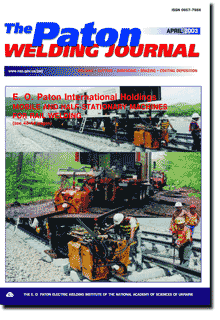

| SCIENTIFIC AND TECHNICAL | |
| Semyonov S.E., Rybakov A.A., Goncharenko L.V., Filipchuk T.N., Drogomiretsky M.N. and Pedko B.I. Evaluation of condition of metal of welded pipes of long-operated gas pipelines. | 2 |
| Service properties of specimens of pipes, cut from operating gas pipeline and also from pipes of emergency stock, are investigated. The feasibility of preserving serviceability of pipe metal after the long-term service is shown. It was established that the decreased characteristics of metal strength of separate pipes as compared with rated values are not due to the effect of service loads. To provide the safe service of the old gas pipelines it is necessary to reveal and remove the metal defects and also to perform the diagnostic examinations with identification of laid-out pipes, evaluation of level of technical characteristics and stability of quality. | |
| Nesterenkov V.M. Special features of capillary waves in the vapour-gas channel in electron beam welding of thick metal. | 7 |
| Features of natural oscillations of liquid metal on the vapour-gas channel walls have been studied. It is shown that in welding with a uniformly-moving electron beam capillary waves form on the melt surface under the impact of reaction force of recoil pressure, arising as a result of electron beam interaction with the channel front wall. These capillary forces have a discrete spectrum of natural frequencies, the density of which increases with the penetration depth. A variance relation has been derived for the capillary waves on the inner surface of a cylindrical channel. Such low-frequency oscillations of the melt may result in instability of the welding process. | |
| Lobanov L.M., Mikhoduj L.I. , Poznyakov V.D., Mikhoduj O.L., Vasiliev V.G. and Strizhak P.A. Towards the problem of formation of longitudinal cracks in welded joints of high-strength steels. | 13 |
| Technological sample and procedure of investigations have been developed that makes it possible to evaluate the effect of residual stresses on resistance of welded joints with multilayer welds to the initiation of longitudinal cold cracks. The resistance to the initiation of longitudinal cold cracks in 14KhGN2MDAFB steel welded joints, made by wire Sv-10KhGN2SMFTYu in mixture of gases Ar + 20 % CO2, was evaluated with allowance for the level of residual stresses. | |
| Maksimov S.Yu., Savich I.M., Zakharov S.M., Zajtseva N.V. and Kozlov E.V. Structure and properties of the metal deposited under the water by flux-cored wire with a nickel sheath. | 18 |
| The paper anlyses the influence of the environment on gas content and density of a high-nickel (60-70 % Ni) weld metal, structure and properties of different zones of the welded joint. In order to improve the indices of their mechanical properties, the alloying, modifying and surface-active elements should be further added to the charge of the flux-cored wire. | |
| Borisov Yu.S. and Kolisnichenko O.V. Effect of plasma-detonation treatment of surface of steel U8 on thermal state and phase composition of modified layers. | 22 |
| Temperature fields of surface layers during plasma-detonation treatment (PDT) of parts were determined through solving the non-stationary heat conduction equation by the finite difference method. The relationships derived were used for analysis of the kinetics of phase transformations in structure of steel U8 during PDT. The calculation-theoretical analysis results were compared with the experimental data. | |
| Grigorenko G.M., Grabin V.F., Golovko V.V., Kostin V.A., Alekseenko I.I. and Kapitanchuk L.M. Procedure of determination of sizes of ultradispersed non-metallic inclusions in metal of low-alloy steel welds. | 26 |
| The procedure envisages to use the numerical methods of obtaining images by scanning electron and light microscopes. The application of optical method of determination of sizes of inclusions using a digital camera gives an opportunity to determine inclusions which sizes exceed 0.07 mm. | |
| INDUSTRIAL | |
| Dobrushin L.D. Precision explosion welding of structures. | 29 |
| The concept of precision explosion welding based on the use of methods and techniques that minimise the pulse effect on a structure and its members is considered. New technologies and products made by these technologies are described, showing the capabilities of precision explosion welding in terms of solving various problems of modern welding production, which are difficult or impossible to solve by other welding methods. | |
| Gorbach V.D. and Chernykh V.V. Ensuring environmental and operational safety of welding production in Russian shipbuilding. | 33 |
| Considered are the systems ensuring environmental and operational safety of welding production in shipbuilding and their harmonisation with international standards. | |
| BRIEF INFORMATION | |
| Ji Cheng Chun and Korinets I.F. Nomogram for determination of the mode of consumable electrode arc welding in a mixture of Ar + 25% CO2. | 37 |
| Deterministic-statistical mathematical model of weld shape was the basis to develop a nomogram, which allows determination of basic parameters of arc welding in a mixture of Ar + 25 % CO2 of a square-butt joint by the specified dimensions of the weld (penetration depth, reinforcement height and weld width), taking into account the size of the gap in the butt, optimization of the mode by weld dimensions or, vise versa, determination of weld dimensions with the known welding mode. | |
| Power supply for metal-electrode pulsed-arc welding. | 39 |
| New book. | 40 |
| NEWS | |
| Presentation of the Silver Sign to President of European Welding Federation. | 42 |
| ADVERTISING | |
| E.O. Paton International Holdings, Inc. | 43 |
(You are viewing the simplified file contents)
